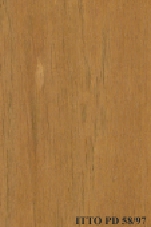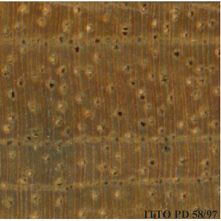
ETIMOé (Copaifera mildbraedii)
Trade Name
Etimoé
Scientific Name
Copaifera mildbraedii Harms
Family
LEGUMINOSAE
Common Names
Ovbialeke (Nigeria); Entedua (Ghana); Etimoé (Côte d`Ivoire); Bofelele (Zaire); Andem-éviné (Gabon); Yama-Bilombi (Central African Republic); Ovbialeke; N`kara; Kamalufu; Indemba; Etimoe; Bangula; Andem-evine
Description Of The Tree
Botanical Description
The tree reaches a height of 32 to 50 m, with trunk diameter from 70 to 100 cm. The bole is straight, cylindrical, and up to 20 to 30 m in length. The buttresses may be absent, slightly developed or well developed.
Natural Habitat
Natural Distribution
West and Central Africa, from Nigeria to the Democratic Republic of the Congo.
Wood Identification
Anatomic Description Of Wood
Wood diffuse porous. Occasionally vessels exclusively solitary (over 90%). Tangential diameter of vessel lumina 150 to 200 micras (medium). Vestured pits. Vessels per mm2 less than 6 (rare). Simple perforation plates. Vessel-ray pits similar to intervessel pits Axial parenchyma in marginal or in seemingly marginal bands. Paratracheal axial parenchyma scanty and/or vasicentric. Axial parenchyma lozenge-aliform. Prismatic crystals in chambered axial parenchyma cells and/or in fibers. 5 to 8 cells per parenchyma strand 4 to 10 rays per mm (medium). Rays non-storied. Rays 1 to 4 seriate. Homogeneous rays and/or sub-homogeneous rays (all ray cells procumbent). Body ray cells procumbent with one row of upright and/or square marginal cells (Kribs-III). Non-septate fibers. Fibers with simple to minutely bordered pits.
-
 Wood Macro Photo Tangential Plane
Wood Macro Photo Tangential Plane
-
 Wood Micro Photo Of Transversal Section
Wood Micro Photo Of Transversal Section
Availability
Cites Status
Unrestricted
General Wood Description
Color
The sapwood is white or greyish white, it has a thickness of 5 to 10 cm. The heartwood is red-brown, often with an attractive veined figure, it is clearly demarcated.
COLOR INDEX (1=Black, 7=Light yellow,white)
4
Grain
Straight or slightly interlocked, sometimes with an influence on further processing operations.
Texture
The wood is mostly medium in texture.
Luster
This wood is commonly of low luster.
Natural Durability
Moderately durable to decay. Without preservative treatment, this species can be used only under risk of occasional re-humidification. It is not suited for uses with risks of permanent or long-lasting humidification. Moderately resistant to termites attack
Natural durability index (1= Very high durability, 7=Vey low durability)
3
Internal Growth Stresses
No growth stresses are reported in this species.
Silica Content
Silica Content: This timber is reported to have a negligible silica content. Silica contents over 0.05% may affect wood processing. Silica Value: 0
Resistance To Impregnation
Nearly impossible to treat with a too much low penetration of the preservative substances.
Wood Physical Properties
Basic Density or Specific Gravity (O.D. weight/vol. green) (g/cm³)
0.61
Air-dry Density (Weight and volume at 12%MC) (g/cm³)
0.68
Total shrinkage Tangential (Saturated to 0%MC) (%)
6.8
Total shrinkage Radial (Saturated to 0%MC) (%)
3.8
Recommended Dry Kiln Schedule
FR-7
Dimensional stability ratio (Total Tangential Shrinkage %/Total Radial Shrinkage %)
1.8
Wood Chemical Properties
Wood Mechanical Properties
Bending Strength (MOR),12%MC (kgf/cm²)
1056
Stiffness (MOE) 12%MC (kgf/cm²)
137639
Compression parallel to fiber 12%MC (kgf/cm²)
650
Compression perpendicular to fiber 12%MC (kgf/cm²)
88
Shear strength radial 12%MC (kgf/cm²)
82
Janka hardness (side) 12%MC (kgf)
573
Janka hardness (end grain) 12%MC (kgf)
672
Workability
Sawing
It is moderately easy to saw.
Rotary Veneer Cutting
Suitable for slicing, also suitable for peeling if treated.
Sliced Veneer
Suitable for slicing, also suitable for peeling if treated.
Blunting Effect
Slight blunting effect; ordinary tools can be used for sawing and machining.
Machining
Machining of this species is reportedly easy.
Planing
Moderately easy; tools must be cautiously sharpened.
Moulding
Easy; no particular problems.
Turning
30
Boring
Easy; no particular problems.
Mortising
Easy; no particular problems.
Nailing
Pre-boring is necessary.
Gluing
Glues well if basic gluing technical rules are followed.
Sanding
Easy to perform; it gives good results.
Polishing
Can be polished without surface preparation.
Response To Hand Tools
Working with hand tools is difficult.
REFERENCED USES
End Uses Summary
HOUSING GENERAL, beams, joists, boards, flooring, parquet, frames, steps, panelling, fittings, FURNITURE AND CABINETS, luxury furniture, cabinets, PLYWOOD AND VENEER, faces, Decorative veneer, TURNING, ornaments, turned furniture, OTHER AND MUSICAL INSTRUMENTS, shingle, moldings
General Housing
- 10 - Silica in Timbers
Beams
- 11 - Prospect: The wood database
Joists
- 12 - Tropical timbers of the world. Part I-Tropical American Species
Boards
- 13 - Dry kiln schedules for commercial woods. Temperate and tropical. Section III. Latin American (Mexico, Central, and South America) Woods–Conventional Temperatures
Flooring
- 14 - Handbook of Hardwoods
Parquet
- 15 - Empire Timbers
Frames
- 16 - Woods of the World
Steps
- 17 - Tree Conservation Database
Paneling
- 18 - W3TROPICOS Missouri Botanical Garden
Fittings
- 19 - Silica in Timbers
Furniture Cabinets
- 21 - Tropical timbers of the world. Part III-Southeast Asian and Oceanian Species.
Furniture, Luxury
- 22 - Dry kiln schedules for commercial woods. Temperate and tropical. Section IV-Asian and Oceanian Woods
Cabinet
- 24 - Empire Timbers
Panels, Veneers
- 25 - Directory of Timber Trade Malaysia
Faces
- 26 - Annual Review and Assessment of the World Timber Situation 1998-ITTO
Decorative veneer
- 28 - Ministry of Agriculture, Fisheries & Forest of Fiji
Turning
- 30 - Embassy of Honduras in Japan
Ornaments
- 31 - Embassy of Colombia in Japan
Turned Articles
- 32 - Embassy of Cote d`Ivoire in Japan
Shingles
- 77 - Amazonian Timbers, Characteristics and Utilization Volume I; Tapajós National Forest
Molding
- 79 - Padronização da Nomenclatura Comercial Brasileira das Madeiras Tropicais Amazônicas, Sugestão
Please Provide Information To View Producer Information